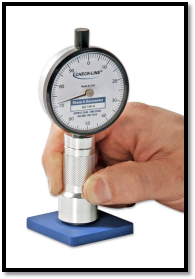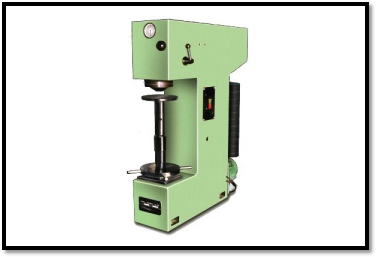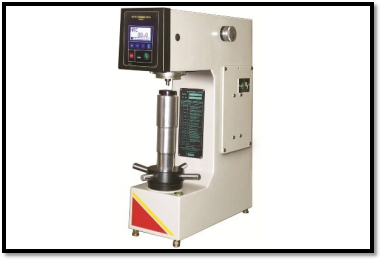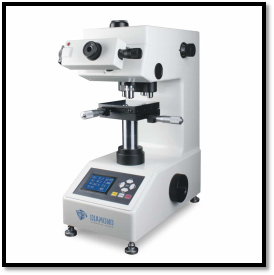What is Durometers: Hardness, Type, and Usage Guide
 Jul 09,2024
Jul 09,2024

Precise material testing serves a pivotal role in evaluating and interpreting the nature of the material for effective usage in demanding applications. The hardness of a certain material determines its ability to ensure optimized performance and quality of the product. Durometer is one of the prime devices that is mainly used to measure the hardness of a material. No matter how soft the material is, this device can give quantify hardness which makes it pivotal to be used in various industrial sectors. In this article, you will be able to understand the basics, working and numerous applications of durometer regardless of your educational background and make effective decisions relating to testing of material hardness.

Figure 1: Durometer
YouTube link:
https://www.youtube.com/watch?v=ZNBNeJ1VRjk&pp=ygUJZHVyb21ldGVy
What is Durometer
An instrument with the sole purpose of measuring the material’s hardness especially that are elastomeric in nature. It comprises of a durometer scale that quantifies the hardness and considerably a standardized way to check material resistance against indentation. Moreover, it scales from 0 to 100 where 0 denotes the softest while 100 denotes the hardest material. Different type of durometer scale includes Shore A, D and IRHD, each designed for a certain type of materials making them capable enough for wide range of applications that demand specific hardness for efficient working.
Historical Context
Albert F. Shore is the pioneer of bringing up the concept of determining the hardness of the material. In 1920s, he was the person who developed the first Shore durometer which was praised worldwide and eventually it became a turning point for industrial sector that demands precise measurements with very less tolerance when it come to properties of the materials. AT first, it was limited to measure the rubber hardness but as we talk of it today, it is a standard tool for plastic and metal as well.
Durometer Units
It has no unit as it is a dimensionless measurement, yet it comprises of Shore hardness scale ranging from 0 to 100 which are used for determining the hardness of different types of materials. This scale is divided into following types which is mentioned below:
- Shore A for soft materials
- Shore D for hard plastic and rubber
- Shore OO for very soft materials
What is a Durometer Used For
The durometer is used in multiple causes and sectors due to its versatility. Below are some of the major departments in which this instrument is highly demanded:
- Quality control
- Material selection
- Product development
- Maintenance and inspection
- Compliance and certification
What is Durometer Rating
A numeric value from 0-100 taken from the durometer that tells material resistance against indentation and make a room for industrialist to compare materials precisely for specific applications. Moreover, it gives an idea that how a certain material will behave under mechanical load in a certain environment. A high rating represents hard material while the low rating represents softer material.
Durometer Hardness Chart
A chart that facilitates comparing hardness level of materials visually. Below is a table showing a hardness chart for some of the materials:
Table 1: Durometer hardness chart
|
Shore hardness |
Material |
Example |
|
Shore 00 |
Soft as well as flexible |
Gel insole |
|
Shore A |
Flexible |
Rubber band |
|
Shore D |
Hard with Semi rigid |
Shopping cart |
|
Shore 10 |
Very soft |
Gelatin |
|
Shore 20 |
soft |
Soft toys |
|
Shore 30 |
flexible |
Inner tube |
|
Shore 40 |
Semi rigid |
Shoe sole |
|
Shore 50 |
Hard |
Golf ball |
|
Shore 60 |
Very hard |
Wood ruler |
|
Shore 70 |
Extreme hard |
Bone |
Understanding Durometer Hardness Scales
The hardness scale of a durometer is crucial to understand for understanding the behavior of materials when they are under mechanical stresses.
Delving into Durometer Scales
Durometer scales are essential tools in the realm of material science, devised to present a standardized method for measuring the hardness of numerous materials. Hence, understanding and interpretation of these scales is important as they are vital in providing a comparative analysis of the materials with precise quality control. Moreover, they are the source of selecting materials and their suitability in a certain application with predictive wear and tear mechanisms which helps the industrialist to schedule maintenance that enhances the lifespan of that material.
Is a Higher Durometer Harder or Softer?
This is predicted with the help of a numerical scale ranging from 1 to 100. The higher durometer ratings on the scale reveal that the material is hard and has more resistance against indentation.
Common Durometer Scales
Common durometer scales are mentioned below with their purpose and usage:
Shore A Scale
This scale is particularly used for interpreting the hardness of materials that are soft in nature. The indenter in this case is typically a truncated cone shaped. Commonly applied on seals, rubber tire etc.
Shore D Scale
This scale is particularly used for interpreting the hardness of materials that are hard in nature including semi rigid polymers and hard plastic. The indent in this case is typically sharper, pointed.
Understanding Durometer Hardness Values
Durometer hardness values are applied to assess the resistance of materials to abrasion as well as indentation. The values are comparative to the hardness of other materials on the identical scale, making it fundamental to recognize the distinct scales. The understanding and interpretation of these values is critical for choosing the optimum material for your application. Moreover, it ensures material meets specification in terms of properties like hardness, durability as well as flexibility.
Types of Durometers and Their Applications
Below is the table showing different types of durometers along with their applications:
Table 2: Types of durometers with applications
|
Types |
Applications |
|
Shore Durometer |
Rubber products, hard plastics, gels |
|
Rockwell Durometer |
Metals, hard plastic ceramics |
|
Brinell durometer |
Metals and alloys, large components, Heavy industrial materials |
|
Vickers durometer |
Aerospace and automotive, Electronics |
|
Knoop durometer |
Brittle materials, thin coatings |
|
Microhardness tester |
Microelectronics, R&D |
How to Use a Durometer
Following are the necessary steps that are involved in using a durometer:
Preparing the Material
First prepare the material before performing a durometer test. This can be done by considering following steps:
- Ensure that the surface is smooth and clean enough without any kind of contaminants.
- Material specimen should have enough thickness to avoid penetration through other side, which can affect the results.
- The temperature of the specimen should be normal along with controlled environment condition.
Selecting the Appropriate Durometer
Another important step is to select the accurate durometer for testing. It totally depends on the type of material you are testing. For softer material, use shore A and for hard material, use shore D and vice versa. Additionally, the specificity of the application also plays a role in choosing the right durometer.
Conducting the Durometer Test
Following are the major steps involved in conducting the durometer test:
YouTube link:
https://www.youtube.com/watch?v=eaMRFQFBGig&pp=ygUZY29uZHVjdGluZyBkdXJvbWV0ZXIgdGVzdA%3D%3D
Interpreting the Results
Evaluation of the results may become challenging in harsh environmental conditions that involve temperature variation and humidity because they strongly influence material hardness. Despite that, if there is shallow indentation, it indicates that the material is hard whereas deeper indentation results in softer material.
Factors Affecting Durometer Readings
Major factors that have a strong influence on durometer readings are discussed below:
Material Composition
The composition of the material plays a vital role in the readings of durometer. Different rubber and elastomers have variable hardnesses which affect the overall readings. Secondly, the presence of fillers and additives in the material alters the durometer reading by enhancing stiffness or flexibility. In addition to this, the variation in the homogeneity of material can also significantly affect the reading.
Environmental Factors
The condition in which the test is being conducted can also impact the durometer readings. Factors like humidity, contaminants on the surface from environment along with variations in temperature can affect the material hardness and compromise the reading of durometer.
Testing Methodology
The method in which the test is being carried out influences the durometer readings. Following are the factors that has a significant effect on methodology and eventually compromising the scale reading:
- Type of durometer
- Variation in durometer applied force
- Contact time between surface and durometer
- Handling of the durometer
- Flatness of the material surface
Expanding the Hardness Testing Landscape: Beyond Durometers
As durometers are only limited to elastomeric materials. There are three other hardness testing techniques for measuring much harder materials along with additional features and capabilities. These are mentioned below:
Brinell Hardness
In this test, the indenter is basically a carbide ball which is 10mm in diameter. When it encounters the material surface, the indentation diameter on that surface is measured. It is mainly applicable to metals and other large components.

Figure 2: Brinell Hardness testing machine
Rockwell Hardness
In this test, two loads are involved i.e., minor load supported by major load. The indenter is a steel ball which penetrates onto the material surface. As a result, the depth of penetration is calculated showing the hardness of the material. It is mainly applicable to composites and hard plastics.

Figure 3: Rockwell Hardness testing machine
Vickers Hardness
This test involves a diamond pyramid indenter which penetrates material surface. The diagonals of indentation (square shaped) are measured and that helps in determining the material hardness. It is mainly applicable to coatings and ceramic materials.

Figure 4: Vicker Hardness testing machine
Comparing Hardness Scales
Following is the table giving a comparative analysis of different hardness scales:
Table 3: Comparison among hardness scales
|
Hardness Scale |
Strengths |
Limitations |
Applications |
|
Shore A |
Soft to flexible materials |
Applicable on soft materials |
rubber silicone |
|
Shore D |
Hard plastics and rubbers |
Not applicable on very soft materials |
Rigid semi-rigid plastics |
|
Rockwell |
Soft to very hard materials |
Different Rockwell scales are applicable for distinct material types |
metals, ceramics hard plastics |
|
Vickers |
Highly accurate as well as precise measurements from soft to hard |
Measurement of indentation challenges |
metals, ceramics hard materials |
|
Brinell |
Large and bulky samples |
Needs a larger sample for testing |
Steel cast iron |
Selecting the Appropriate Hardness Test
Choosing the right test for measuring the hardness of the material is pivotal because the entire mechanical properties and its usage in application depends on the correct measurements. Following parameters should be kept in mind while selection of appropriate technique:
- Material type
- Desired accuracy and precision
- Testing requirements
Considerations for Engineers and Designers
Various important factors and parameters should be kept into consideration especially by designers and engineers while manufacturing a certain product or component for required application.
Impact of Hardness on Material Properties
Hardness has the sustential effect on various material properties including strength, ductility and wear resistance.
- Materials that exhibit high hardness value tend to have exceptional strength as well as impact resistance.
- Low hardness value influence material ductile behavior which is suitable for application including plastics and other soft metal.
- Harder material also comprise of good wear resistant which extend the overall lifespan of the material component.
Designing for Specific Hardness Requirements
Components that require specific hardness ensure longer lifespan and performance efficiency. Designing such components is not an easy task, as they require specific conditions for testing such as functionality in various environments that it must sustain along with material compatibility to bear load.
Specifying Hardness in Engineering Drawings
To specify hardness, you need to identify which scales are commonly used in engineering drawing. These are as follows:
- Rockwell Hardness (HRC)with a notation HRC XX-XX or HRC XX min.
- Brinell Hardness (HB) with a notation HB XXX
- Shore Hardness (Shore A, Shore D) with a notation Shore A XX or Shore D XX
How Tuofa Can Help You
Tuofa helps you in ensuring durability as well as quality of the product by providing following facilities:
- Hardness Testing Expertise
- Precision Machining Excellence
- Collaborative Partnership with experts
Conclusion
In conclusion. hardness testing plays a significant role in determining and interpreting the overall mechanical properties of a certain material. Therefore, effective and optimum tools should be used for calculating such important characteristics of a material. The Durometer, due to its unique set of features, has been an important tool for industrialists as well as engineers in finding effective solution for increasing the lifespan of the material component along with durability and efficiency.
FAQ
Why does Durometer Matter for CNC Parts?
It guarantees optimized hardness of the material, increasing the durability as well as performance in precise machining components.
70 Durometer vs 90 Durometer
70 Durometer is convenient for softer materials like gaskets while 90 durometer is for harder materials such as seals.
What is Dual Durometer
Material with variable level of hardness within a single part or component refers to dual durometer i.e., blend of rigidity and flexibility.
Shore Hardness vs Durometer
Shore Hardness is the technique used to measure the material hardness and durometer is the tool used for this purpose.
 Tel/WeChat:
Tel/WeChat:  Email:
Email: 
 Home
Home
 Understanding Copper And Why Dosen't Copper Rust
Understanding Copper And Why Dosen't Copper Rust 







